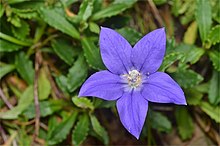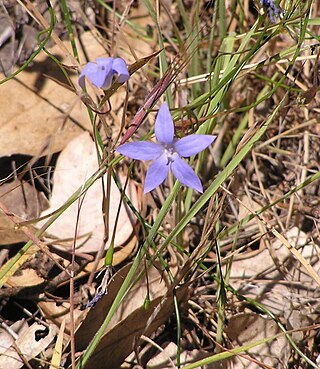
Wahlenbergia is a genus of around 260 species of flowering plants in the family Campanulaceae. Plants in this genus are perennial or annual herbs with simple leaves and blue to purple bell-shaped flowers, usually with five petals lobes. Species of Wahlenbergia are found on all continents except North America, and on some isolated islands, but the greatest diversity occurs in the Southern Hemisphere.

Wahlenbergia stricta, the Australian bluebell, tall bluebell or austral bluebell, is an Australian wildflower from the Campanulaceae family. It is considered the most commonly encountered of the Wahlenbergias. It is found in all Australian states but not the Northern Territory. It is often seen growing by the side of the road, enjoying the extra runoff.

Eucalyptus crebra, commonly known as the narrow-leaved ironbark, narrow-leaved red ironbark or simply ironbark, and as muggago in the indigenous Dharawal language, is a species of small to medium-sized tree endemic to eastern Australia. It has hard, rough "ironbark" from its trunk to small branches, linear to lance-shaped adult leaves, flower buds in groups of seven, nine or eleven, white flowers and cup-shaped, barrel-shaped or hemispherical fruit. A variable species, it grows in woodland and forest from the Cape York Peninsula to near Sydney. It is an important source of nectar in the honey industry and its hard, strong timber is used in construction.
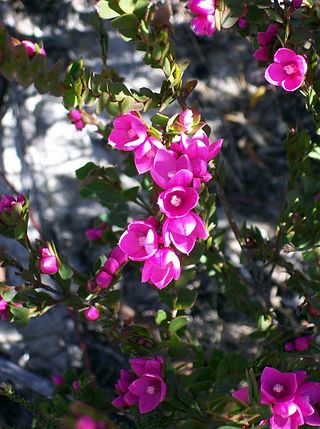
Boronia serrulata, commonly known as native rose or rose boronia, is a species of plant in the citrus family, Rutaceae, and is endemic to New South Wales, mainly in the Sydney basin. It is an erect, woody shrub with glabrous branchlets, simple, egg-shaped leaves with fine teeth on the edges, and bright pink, four-petalled flowers on the ends of the branchlets.

Hovea linearis is a species of flowering plant in the family Fabaceae and is endemic to eastern Australia. It is an erect or trailing subshrub with mostly narrowly linear to linear leaves with stipules at the base, and mauve and yellowish-green, pea-like flowers.

Bossiaea heterophylla, commonly known as variable bossiaea, is a species of flowering plant in the family Fabaceae and is endemic to south-eastern Australia. It is a variable shrub with flattened stems, egg-shaped to linear leaves, and yellow and dark red flowers.

Hesperocodon hederaceus, synonym Wahlenbergia hederacea, also known as the ivy-leaved bellflower, is a species of flowering plant that is found throughout Europe. It is the only species in the genus Hesperocodon. The delicate, patch-forming, hairless perennial herb has thin, creeping stems about 20 cm in length. Its pale green leaves are long-stalked and have an ivy-shaped, rounded structure. These leaves can be described as having a cordate shape and are approximately 5–12 mm long and wide. The plant has erect, solitary, pale blue flowers in summer and autumn, with bell-shaped corolla with 5 short lobes. The flowers are 6–10 mm long x 5–8 mm wide and sit on fine stalks 1–4 cm long. It is suggested that the long pedicels are an adaptation to assist in seed dispersal.

Leptospermum obovatum, commonly known as river teatree, is a species of shrub that is endemic to south-eastern continental Australia. It has egg-shaped or lance-shaped leaves that are narrower at the base, white flowers usually arranged singly on short side shoots and fruit that remains on the plant until it dies.
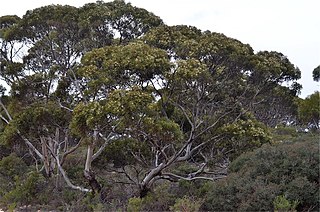
Eucalyptus gracilis, commonly known as yorrell, snap and rattle, red mallee, white mallee or kong mallee, is a species of mallee or small tree endemic to Australia, where it is found in south-western New South Wales, Victoria, South Australia and Western Australia. It has smooth white bark, usually with rough, fibrous or flaky bark on the lower stems, linear to narrow lance-shaped adult leaves, flower buds in group of between seven and eleven and cup-shaped, cylindrical or barrel-shaped fruit.

Grevillea humilis is a species of flowering plant in the family Proteaceae and is endemic to eastern New South Wales. It is an erect to spreading shrub with narrowly elliptic to more or less linear leaves, and pink or white flowers.

Lobelia anceps, commonly known as angled lobelia, is a small herbaceous plant in the family Campanulaceae it grows in several states of Australia, New Zealand, South America and South Africa. It is a small, perennial herb with blue to purple flowers.

Wahlenbergia capillaris, commonly known as tufted bluebell, is a plant in the family Campanulaceae and is native to Australia and New Guinea. It is an erect perennial herb with a few to many stems and grows to a height of 50 cm (20 in). The leaves are mostly linear with a few scattered teeth on the sides and the flowers are blue, bell-shaped with five lobes and arranged in cymes. This bluebell is widespread and common, occurring in all Australian mainland states and territories.

Wahlenbergia capensis, commonly known as the Cape bluebell, is a plant in the family Campanulaceae and is native to the Cape Province but has been introduced to Australia. It is an annual herb with up to four greenish blue, bell-shaped flowers with spreading petal lobes.
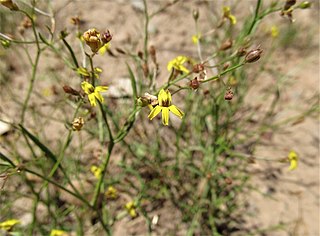
Goodenia gracilis, commonly known as slender goodenia, is a species of flowering plant in the family Goodeniaceae and is endemic to Australia. It is an annual or perennial herb with linear to lance-shaped leaves and racemes of yellow flowers.

Pultenaea divaricata is a species of flowering plant in the family Fabaceae and is endemic to a small area of New South Wales. It is an erect shrub with linear, needle-shaped, grooved leaves, and dense clusters of yellow to orange flowers with red markings.

Hovea asperifolia is a species of flowering plant in the family Fabaceae and is endemic to south-eastern continental Australia. It is a shrub with hairy branchlets, narrowly oblong to narrowly linear leaves with stipules at the base, and mauve, pea-like flowers.
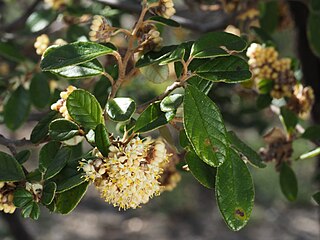
Pomaderris betulina, commonly known as birch pomaderris, is a species of flowering plant in the family Rhamnaceae and is endemic to south-eastern continental Australia. It is a shrub with hairy young stems, lance-shaped to oblong or elliptic leaves, and yellowish flowers.

Lobelia browniana is a species of flowering plant in the family Campanulaceae and is endemic to eastern Australia. It is an erect, glabrous, annual plant with narrow leaves and one-sided racemes of blue flowers with long, soft hairs in the centre.

Hovea graniticola is a species of flowering plant in the family Fabaceae and is endemic to eastern Australia. It is a shrub with its branchlets covered with curly brownish to grey hairs, narrowly oblong to almost linear leaves with stipules at the base, and mauve, pea-like flowers.
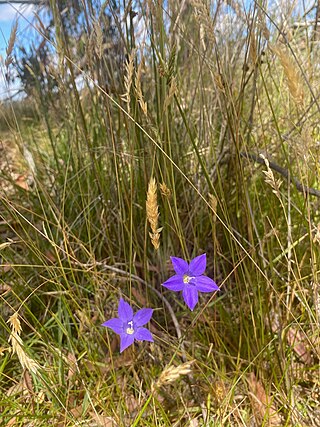
Wahlenbergia gymnoclada, commonly known as the naked bluebell, is a species of plant of the family Campanulaceae and is native to Australia. It is one of 200 species, in the Wahlenbergia genus. Of these species, 26 occur in Australia, including one introduced, and Tasmania has seven species of native Wahlenbergia. Species in this genus are “all slender perennial herbs and most species occur in grassy vegetation, although one occurs in rocky alpine areas. “The slender pedicels with delicate blue, symmetrical, flowers make this a relatively distinctive genus. The corolla tube is bell shaped, often with more or less spreading lobes”.
